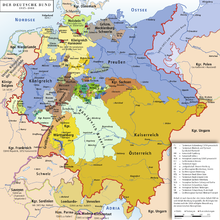
Back كلاينشتاتراي Arabic Kleinstaaterei German Kleinstaaterei Spanish Kleinstaaterei Estonian Kleinstaaterei French Kleinstaaterei Galician Kleinstaaterei Hungarian Kleinstaaterei Armenian Kleinstaaterei ID Kleinstaaterei Italian


| History of Germany |
|---|
 |




The word Kleinstaaterei (German: [ˌklaɪnʃtaːtəˈʁaɪ], "small-state-ery") is a pejorative term coined in the early nineteenth century to denote the territorial fragmentation of Germany.[note 1] While the term referred primarily to the territorial fragmentation of the German Confederation, it is also applied by extension to the even more extreme territorial fragmentation of the Holy Roman Empire. In this period, Germany was split into a great number of nearly sovereign small and medium-sized secular and ecclesiastical principalities and free imperial cities, some of which were little larger than a single town or the surrounding grounds of the monastery of an Imperial abbey. Estimates of the total number of German states at any time during the 18th century vary, ranging from 294 to 348,[2] or more. However, the number of states rapidly decreased with the onset of German mediatisation in the early 19th century.
Territorial fragmentation was compounded by the fact that, due to the haphazard territorial formation of many states or the partition of dynastic states through inheritance, a very large number of Holy Roman Empire states were constituted of non-contiguous parts, which resulted in countless enclaves and exclaves.
An example of the territorial fragmentation is the story of how a young Wilhelm von Humboldt and his friends traveled from Brunswick, capital of the Principality of Brunswick-Wolfenbüttel, to France in the summer of 1789. In order to observe the revolutionary events unfolding in Paris, Humboldt's party entered and exited six duchies, four bishoprics and one free imperial city (Aachen) before reaching the French border.[3]
- ^ J. Whaley, Germany and the Holy Roman Empire (1493–1806), Oxford University Press, 2011, vol. 2, p. 653 (Glossary).
- ^ The Times, Atlas of European History, Harper Collins, 1994, p. 127
- ^ E. D. Brose, German History 1789–1871. From the Holy Roman Empire to the Bismarckian Reich, Berghahn Books, 1997, p. 4.
Cite error: There are <ref group=note> tags on this page, but the references will not show without a {{reflist|group=note}} template (see the help page).
© MMXXIII Rich X Search. We shall prevail. All rights reserved. Rich X Search